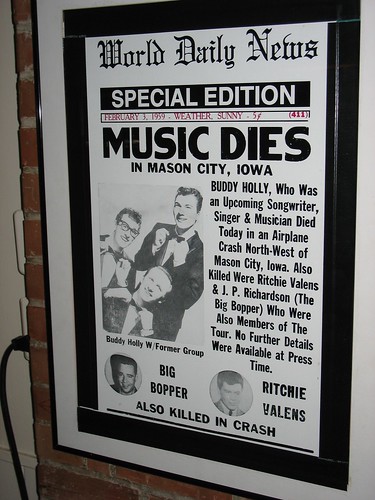
From CHRON
Part of the lasting appeal of Buddy Holly and the Winter Dance Party — the infamous tour of the Midwest that ended tragically with a Feb. 3, 1959, plane crash — is the allure of youthful promise cut short. We, of course, will never know what might have happened had Buddy, Richie Valens and the Big Bopper elected to stay on the bus on that frigid February night 50 winters ago.
But as a music writer who grew up with the music and has covered rock ‘n’ roll for 30 years, I offer some thoughts on how things might have played out.
•Buddy Holly: Today, we remember Holly as a great innovator, one of the first to add strings to a rock ‘n’ roll recording, a superb songwriter and the man who made it permissible for gawky white guys with thick glasses to rock.
What we tend to forget is that in early 1959 his career was in crisis. He had split with his producer and his band, and he was short on cash. His last four singles had tanked; the last two peaked at No. 68 and No. 82 respectively. Even in 1959, you didn’t tour in Mankato, Minn., if your career was thriving.
Would talent alone have been enough for Holly to turn it around? Perhaps, but I’m skeptical. In the late ‘50s, pop music was moving toward the era of teen idols like Fabian, Frankie Avalon and Bobby Rydell. That wouldn’t have been a good trend for geeky, spectacled Texans.
On the other hand, Holly’s final singles, It Doesn’t Matter Anymore and Raining In My Heart, signaled a move to a softer, more polished ballad style that would have fit in well with the musical temper of the early ’60s.
Of course, like every American rocker except Elvis, Holly would have been blown off the map by the Beatles and the British Invasion in 1964. But he would also have been positioned to regroup. Holly’s early roots were in country music, and I suspect he, like Conway Twitty and Jerry Lee Lewis, would have returned there — if not as a performer, then as a songwriter and producer.
•Richie Valens: Valens was really just a high school kid, 17 years old when he died. There’s barely a legacy there, just a handful of recordings, but on some of them he rocked like a guitar-crazed banshee. Just listen to Come On, Let’s Go or his version of Boney Maronie.
Valens had enormous potential, although his beefy looks probably wouldn’t have helped in the Cute Boys from Philly era. La Bamba was really just a rocked up Mexican folk tune, but it carries at least the suggestion that Valens might have prospered in the folk rock era of the mid-’60s.
•J.P. “The Big Bopper” Richardson: Let’s be honest. If it had not been for that plane crash, Richardson the singer would have been a forgotten one-hit wonder by now. Chantilly Lace was a one-dance-and-you’re-out novelty hit. On the other hand, Richardson wrote White Lightning for George Jones and Running Bear for Johnny Preston. Both of them were No. 1 one hits. It’s possible that he would eventually have found his place in Nashville as a successful songwriter.

No comments:
Post a Comment